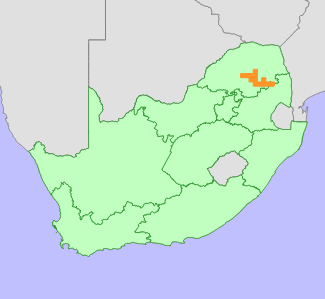|
Scientific Name | Adenia fruticosa Burtt Davy subsp. fruticosa |
Higher Classification | Dicotyledons |
Family | PASSIFLORACEAE |
Common Names | Green-stem (e) |
National Status |
Status and Criteria | Near Threatened A2c; B1ab(iii,v)+2ab(iii,v) |
Assessment Date | 2018/10/01 |
Assessor(s) | L. von Staden, J.E. Victor & A.E. van Wyk |
Justification | A population reduction of 20-30% for Adenia fruticosa subsp. fruticosa is estimated based on habitat loss in low-lying areas due to agriculture, expanding human settlements and mining in the past 100 years (generation length 50 years). It has an extent of occurrence (EOO) of 5900 km², and an area of occupancy (AOO) of less than 2900 km². There is a continuing decline in the habitat, but population reduction is unlikely to exceed 30% within the next generation (50 years) as this subspecies also occurs on rocky slopes in more remote mountainous areas that are unlikely to be impacted by development and agriculture, and more than 10 locations remain. It is used for traditional medicine, but is at present not harvested in large volumes for the commercial muthi markets. It is listed as Near Threatened under criteria A and B. |
Distribution |
Endemism | South African endemic |
Provincial distribution | Limpopo, Mpumalanga |
Range | This species is endemic to South Africa, and is found in Strydpoort Mountains southwards to Ohrigstad and the Steelpoort River Valley. |
Habitat and Ecology |
Major system | Terrestrial |
Major habitats | Sekhukhune Mountain Bushveld, Sekhukhune Plains Bushveld, Ohrigstad Mountain Bushveld, Poung Dolomite Mountain Bushveld, Mamabolo Mountain Bushveld |
Description | It occurs in arid woodland, rocky outcrops, slopes and sandy flats, on dolomite, granite and quartzite, 800-1400 m. |
Threats |
| Habitat in low-lying areas are transformed by agriculture, human settlements and mines. About 20% was already transformed in 1996 (estimated using GIS), and transformation has been ongoing in the last 10 years, but is unlikely to be more than 30%. Higher lying areas are at present mainly utilized for grazing, which is unlikely to impact this species.
The local population has customary medicinal uses for the swollen stem (P.J.D Winter pers. comm.), but this species is not harvested in large quantities for the commercialized muthi markets. It is occasionally seen on the markets, but the more popular A. gummifera tends to be more prevalent (A.E van Wyk pers. comm.). |
Population |
There is no information available on the population of this species.
|
Population trend | Decreasing |
Assessment History |
Taxon assessed |
Status and Criteria |
Citation/Red List version | | Adenia fruticosa Burtt Davy subsp. fruticosa | NT A2c; B1ab(iii,v)+2ab(iii,v) | Raimondo et al. (2009) | |
Bibliography |
De Wilde, W.J.J.O. 1976. Passifloraceae. In: J.H. Ross (ed). Flora of southern Africa 22:104-128. National Botanical Institute, Pretoria.
Raimondo, D., von Staden, L., Foden, W., Victor, J.E., Helme, N.A., Turner, R.C., Kamundi, D.A. and Manyama, P.A. 2009. Red List of South African Plants. Strelitzia 25. South African National Biodiversity Institute, Pretoria.
Venter, S. 1993. Notes on the genus Adenia with special reference to the Transvaal species. Aloe 30(3/4):83-89.
|
Citation |
| von Staden, L., Victor, J.E. & van Wyk, A.E. 2018. Adenia fruticosa Burtt Davy subsp. fruticosa. National Assessment: Red List of South African Plants version 2024.1. Accessed on 2025/11/18 |
 Comment on this assessment
Comment on this assessment

